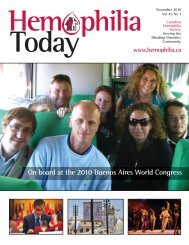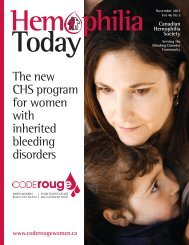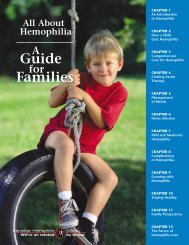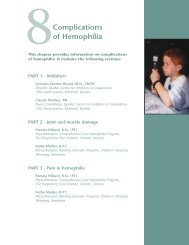Canadian Hemophilia Society Meeting the challenge
Canadian Hemophilia Society Meeting the challenge
Canadian Hemophilia Society Meeting the challenge
- No tags were found...
Create successful ePaper yourself
Turn your PDF publications into a flip-book with our unique Google optimized e-Paper software.
More than ever, our national organization needs to stay abreast of safety and supply issues. Ourchapters must be informed, proactive and able to advocate on behalf of people with bleeding disorders andour bleeding disorder treatment centres. Access to <strong>the</strong> most advanced <strong>the</strong>rapies at no cost to <strong>the</strong> end user,delivered by well-resourced clinics, will be <strong>the</strong> key advocacy focus for <strong>the</strong> CHS in coming years.Ano<strong>the</strong>r <strong>challenge</strong> is under-diagnosis. There may be 30,000 <strong>Canadian</strong>s with symptoms of bleeding disordersserious enough to require specialized care, yet only 8,500 are registered in Canada’s comprehensive carecentres. In 2011, <strong>the</strong> CHS developed its CODErouge program to reach out to women with bleeding disorders.The program was officially launched in May 2012. Over <strong>the</strong> next three years, <strong>the</strong> CHS will be working closelywith <strong>the</strong> Association of <strong>Hemophilia</strong> Clinic Directors of Canada and <strong>the</strong> <strong>Society</strong> of Obstetricians andGynaecologists of Canada to raise awareness about bleeding disorders in women, and to improve diagnosisand care.There are <strong>challenge</strong>s within <strong>the</strong> CHS as well. We are re-defining our membership categories to include ourpartners in <strong>the</strong> clinics. We are working more closely with staff in those clinics to make sure that all people withbleeding disorders know of, and can have access to, CHS programs and services. We are reviewing our by-lawsin light of <strong>the</strong> recently adopted Canada Not-for-profit Corporations Act (CNCA). In 2012, in an effort to domore with less, <strong>the</strong> Board of Directors has decided to discontinue most face-to-face committee meetings andone of its two annual board meetings. We are required to work smarter, adopt communication tools such aswebinars and increase <strong>the</strong> frequency of teleconferences. In addition to <strong>the</strong>se changes, <strong>the</strong> CHS will also bemaking a decision to restructure <strong>the</strong> national board, reducing its size almost in half from its current 25directors. The goal of <strong>the</strong> restructuring is not only to reduce expenses but also to enhance directoraccountability, and increase collaboration and board effectiveness.Challenges can be barriers to progress but <strong>the</strong>y can also be opportunities to innovate and grow.We are optimistic for <strong>the</strong> future of <strong>the</strong> organization and our collective ability to advocate for optimalcare and treatment.2011 Annual Report5
















